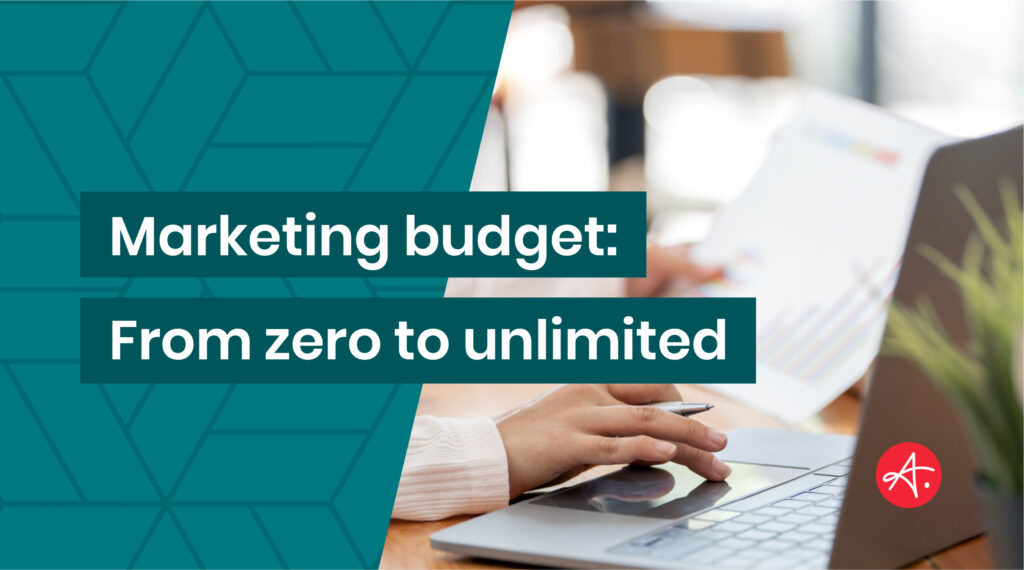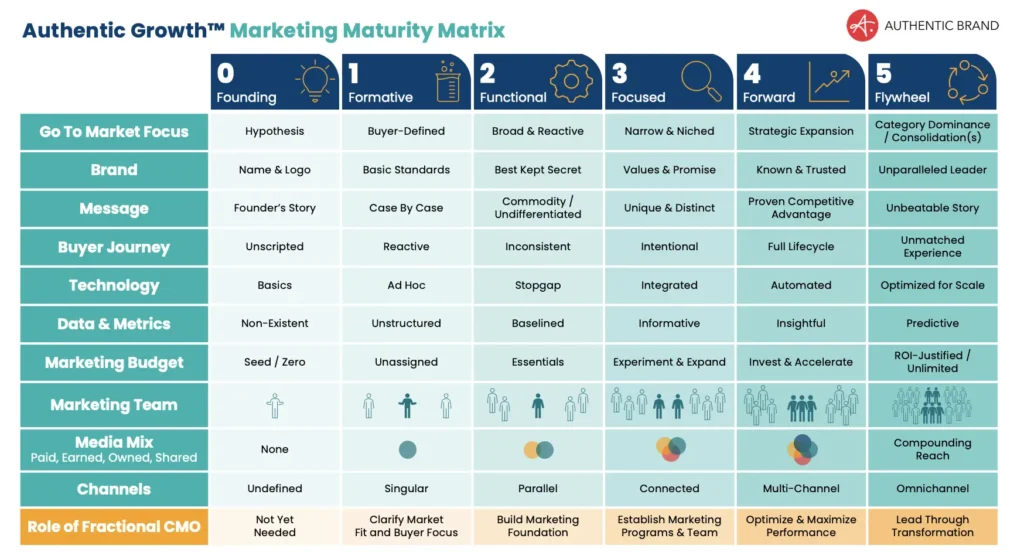Marketing budget: From zero to unlimited

When it comes to a marketing budget, there’s no easy button.
Business leaders often want us to tell them how much to allocate to their marketing budget. But there’s no easy answer to this question; no universal formula exists that works for all companies due to varying factors, such as industry, business model, market, company culture, appetite for investment, the maturity of the existing marketing programs, and how quickly they’re willing to change.
Another common scenario occurs when leaders will then tell us their marketing budget is unlimited — so long as we can guarantee ROI for each dollar spent. But this sentiment often comes with unrealistic expectations about the effort, time, and expenditure needed to develop a consistent, ROI-yielding marketing engine.
This leads to a recurring cycle of trial and error: invest for 90 days → get frustrated by the unclear ROI → pull the plug (and abandon any progress) → pick a new tactic → start again. To help businesses overcome this pattern of random acts of marketing, we use our Authentic Growth™ Marketing Maturity Matrix. With our matrix, we help growing companies recalibrate their expectations and shift from short-term activities and costly cycles of experimentation to long-term value creation.

The path to “unlimited” budget: Stages 0 to 5
Every business wants to invest in the channels and initiatives that reap the greatest return for the business. This is the point of marketing, after all. But maturing to a stage when the marketing team has the trust, confidence, and historical proof points to justify an increasing budget requires effective marketing leadership, clear insights, and agile decision-making. This takes time and thoughtful growth.
The following six stages demonstrate how a company moves through the progression of marketing budget maturity.

Stage 0: Founding – Seed/Zero
In the earliest days of a business, marketing spend is about buying what the founders need to get the company going (e.g., domain name, logo, basic website, and simple sales collateral). Investments are typically scrappy, and a marketing budget likely isn’t even a concept yet. Some early-stage companies are funded by investors or equity partners, but many companies get their start through bootstrapping: funding their growth with their own money and early sales. Whatever the situation, marketing is usually on a shoestring budget and cobbled together through a combination of DIY and gig marketplace freelance capabilities.
How to mature to the next stage: Now is the time to prove the business hypothesis, make some initial sales, and collect data about your ideal customers and how the solution you’re bringing to market resonates with them. Understanding what resonates with customers will help you build a solid foundation for determining which marketing investments will likely be the most impactful with your audience.
What you’ll need: An initial customer base for data collection and feedback, a clear understanding of the solution you’re offering, and some general ideas for what marketing activities might reach your ideal audience most effectively.

Stage 1: Formative – Unassigned
In this stage, you have more experience and more predictable cash flow. You know roughly how much you’re comfortable spending on marketing based on your operating budget and margin. However, your marketing budget isn’t mature yet; you haven’t assigned different amounts to different categories based on their effectiveness. Instead, you invest in marketing activities based on what the founder expects or what prospects and customers are asking for.
For example, a prospect asks for a one-page sales sheet and case studies, so you create those. The founder is shifting the company pitch, so you create a new PowerPoint template to reflect that. Marketing consists of ad hoc, tactical projects based on requests; your marketing is buyer- or founder-defined and reactive.
How to mature to the next stage: Prioritize marketing investments based on what you need in order to sell what you’re selling. Meanwhile, track how much everything costs to produce or activate to get a better sense of how much you’re allocating to different categories and what you can afford based on the budget you’ve allocated. Start to think about what your marketing mix across different channels and initiatives might look like in the coming year.
What you’ll need: A percentage of your operating budget that you are comfortable spending on marketing, an understanding of how much specific marketing initiatives cost, and some initial ideas about which channels and initiatives are most worth investing in.

Stage 2: Functional – Essentials
When you reach stage two, your marketing budget is starting to mature. You have a line-item budget that separates out your marketing spend into categories, which may include creative, content, digital, events, sponsorships, etc. You may also have some ideas for new activities and initiatives you want to test and their associated costs.
Even though your marketing efforts are beginning to shift in the right direction, the founder or owner is likely still dictating the marketing activities; you may have some resources dedicated to marketing (e.g., a coordinator and some freelance or agency partners), but you likely lack strategic marketing guidance.
How to mature to the next stage: Now is the time to create more accountability for marketing investment. Up to this point, you’ve been “trying on” various tactics (blog, email, SEO, PPC, sponsorships, social media), to get a sense for what resonates with your ideal buyer. Engagement metrics — such as clicks, follows, likes, visits — can be leading indicators, but they really don’t mean anything unless they are driving desired conversions, and ultimately, sales. It’s time to move from activity metrics to conversion metrics as a measure of your marketing effectiveness.
Consider whether you have the marketing expertise on staff to help you move in a more strategic direction or if you need to hire someone to fill this marketing leadership gap.
What you’ll need: Clear goals for each marketing channel and campaign, based on the engagement metrics to date. Make assumptions from whatever baseline data you’ve already captured, and then continue to measure trends and conversion points so that you can start to understand which of your efforts are leading to qualified leads and sales. This is also a critical time to have a plan for engaging strategic marketing leadership to help you continue maturing.

Stage 3: Focused – Experiment & Expand
At this stage, strategic marketing leadership is absolutely crucial. This leadership will help you evaluate legacy marketing programs to assess whether they’re working and fit into where you’re going as a business. An experienced marketer can partner closely with the finance team to help inform the budget, directing investments toward the initiatives that reach your ideal audiences and support your business objectives.
How to mature to the next stage: Start to think about making long-term investments into your brand and stakeholder relationships; balance investments in short-term initiatives, like campaigns and content, with initiatives that may not demonstrate immediate engagement or conversion but will help build your brand in its intended ecosystem, like strategic partnerships, referral channels, and earned media (public relations and awards). These long-term investments build brand value and support sustainable growth while marketing technology, processes, and systems underpin the marketing engine to help your business scale.
These brand-building exercises will help you develop deeper trust, stronger credibility, greater brand recognition, and clearer differentiation. Factor all of these initiatives into annual marketing planning and create a marketing plan that allocates your budget strategically to different categories. Identify the metrics you’ll track to help you evaluate marketing performance, so you can reallocate flexibly throughout the year if certain initiatives are under- or over-performing.
What you’ll need: An experienced marketing leader to guide you through this critical phase of marketing strategy. A dashboard of meaningful metrics that help you evaluate marketing performance and provide insights that inform if you need to reallocate budget midyear. Nimbleness with your marketing budget as you continue to experiment with different investments to identify what’s most effective for your business. An appetite for taking small risks, but a willingness to learn from them quickly and evolve.

Stage 4: Forward – Invest & Accelerate
By stage four, you have learned and experimented extensively, achieving clarity on your market, audience, and buyer’s journey. Armed with data, you can identify which initiatives and channels resonate, engage, and bring in qualified connections and which ones do not. At this stage, you should prepare to invest in strategic expansion, doubling down on successful initiatives while moving funds away from less effective ones.
How to mature to the next stage: Continue refining your marketing budget for maximum impact by examining KPIs that demonstrate your performance across channels and adjusting investments accordingly. Insights you glean from one channel can help inform how you approach another channel; this is called omni-channel marketing. Omni-channel marketing integrates channels to create a seamless customer experience, unlike multi-channel marketing, which treats each channel as a separate engagement silo.
What you’ll need: A willingness to invest more into marketing because the business has the structure needed to move a qualified prospect through to a sale and serve it well. A system for regularly tracking your KPIs, including the cost of conversion, the total cost of acquisition, customer lifetime value, and the time it took to convert. Continuous refinement of your marketing budget based on KPIs.

Stage 5: Flywheel – ROI justified / unlimited
By stage 5, your marketing program is a well-oiled machine, and there is good rationale to justify an unlimited marketing budget. But a completely unrestricted budget is rare (or nonexistent) because you have to continue to prove ROI, which never stays static. Changing markets, economic realities, and competitive forces require vigilant attention and continued marketing innovation.
So while an unlimited budget is unrealistic, an ROI-justified budget gives you the freedom to continue investing because you’ve demonstrated you know how to approach marketing with the kind of agility that builds healthy growth.
How to continue maturing: Don’t get complacent, and keep your eye on the market. Invest in the ongoing education of your marketing team so they are prepared to navigate the constant evolution of technologies and trends that impact their work. And above all, continue to ensure that everything you do ties to the company’s purpose and vision.
Responsible stewards of budget and growth
A mature and optimized marketing budget that drives sustainable business growth requires strategic marketing direction and leadership. At Authentic, our fractional CMOs have guided companies at various stages of growth and marketing maturity toward budgets that drive impact — but stay agile.
Our fractional CMOs know how to resource teams and programs, push back on requests that don’t align with the strategy or support the vision, and are responsible stewards of our clients’ resources — ensuring they’re pointed in the best possible direction to attract the healthiest, most profitable type of growth.
Let’s connect if you’re interested in discussing how an Authentic Fractional CMO™ can help you chart a strategic plan, back it with the right level of investments, and adjust it as you track your performance.
